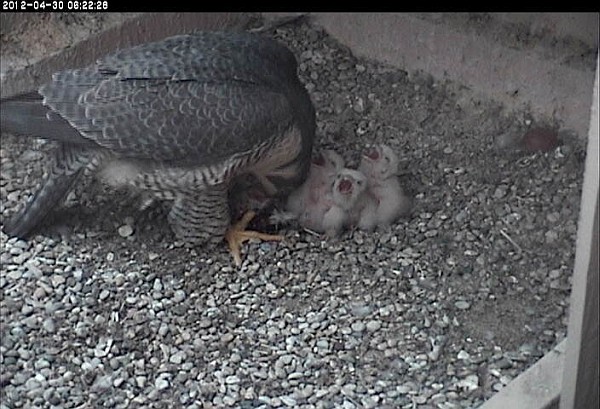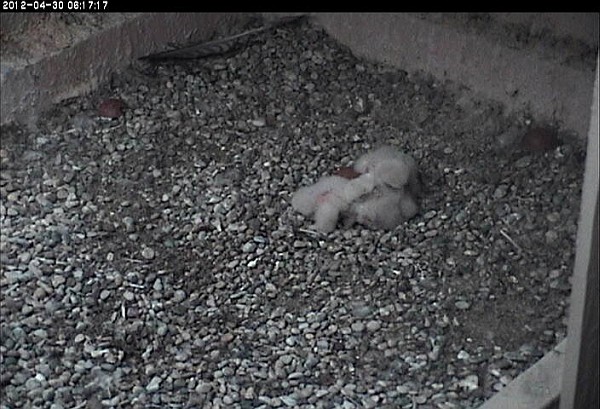
This morning at the Cathedral of Learning three hungry peregrine chicks begged Dorothy for breakfast. At least one was so hungry that he started begging while she was still brooding them.
At dawn E2 announced breakfast off camera. When Dorothy got up to receive it, I could see the fourth egg still unhatched.

Hatching can take 72 hours from first pip, which was visible yesterday morning. So we wait.
Meanwhile the new chicks are perfecting their begging skills. When they slow down Dorothy encourages them by “chupping.”
“Eat!” she says, and they raise their heads again and open their beaks.
So cute!
Watch them on live streaming video here.
(photo from the National Aviary falconcam at Univ of Pittsburgh)
Thank you for the photos–so very cute. Welcome, hungry little ones!!
They are so adorable. Look at how wide they open!!!
Just an observation — Those peregrine parents in Harrisburg seem to be making quite a dent in the songbird population around the nest site. I have seen feathers or heads from at least a couple of woodpeckers, a couple of bluejays, and a flicker, plus some babies from a nest somewhere. Too bad they don’t eat starlings, or stick to pigeons!! It is sad to see so many of our more friendly and familiar garden and feeder visitors being taken as food, when the more undesirable birds continue to proliferate.
We have the same issue here in California, and with all the hoopla regarding the windmills in the Altamont Pass, which is within a half hour of here, at least the number of hunting birds is kept down a bit. Even with that, we had hawks take out the robins’ nests all last summer and kill our beautiful and friendly mockingbirds, and there are falcons and hawks that target birds that come to our feeding areas here in the neighborhood on a regular basis. I shudder to think what might happen if they completely shut down the windmill farms. (Currently they already limit operation to certain times of year in regard to the birds). I value the birds (and love following the Pgh peregrines, and our local ones too), but I also value the clean energy generated by the wind. There is room for both.
bhancey, I hear ya but… many species of falcons and hawks can only digest meat. They must kill to eat.
http://www.birdsoutsidemywindow.org/2008/01/24/no-they-wont-eat-corn/
Predators capture the individuals that are easiest to catch. Though we worry about our favorite songbirds, prey species compensate by producing many, many, MANY more babies than will live to adulthood. Robins do this by laying 3-5 eggs per clutch and nesting 2-3 times per year. There is high fledgling mortality but robins who make it to adulthood generally live 5-6 years. So… a single robin could produce 40-60 baby robins in its lifetime.
Predators keep the number of robins — and many other things — in balance. Here’s what happens when there are no predators for rabbits:
http://en.wikipedia.org/wiki/Rabbits_in_Australia
I know all about a lack of sufficient balance (starlings and other blackbirds are a huge example), but our robins in this area truly struggle, and the numbers are noticeably down, at least in our area. This morning I watched a hawk take out the second of the yellow-billed magpie nests near my work. They are incredible birds – but fairly slow, and not aggressive enough to defend against hawks or other large predators. The yellow-billed magpies only live in this area – the Central Valley of California, and over the hill in the Livermore Valley area, and their habitat is shrinking. We enjoy the pair (or possibly two) that hang out in our neighborhood, but also know that there is a family of hawks as well as a family of falcons within striking distance of their nest sites. We have our fingers crossed for them.
Bhancey, sorry to hear the sad news about robins in Calif and even sadder news about the Yellow-billed magpies. I have never seen a yellow-billed magpie. 🙁
We have lots & lots of robins here, quite enough to share with the West.
Dear Kate, do you think that last egg will hatch? Any signs that it’s trying to get out? The three little ones are growing so fast that I worry that the fourth one will be far behind its siblings, if/when it decides to make its appearance.
I recall all those wonderful robins back east – we lived in Virginia, and I grew up north of Pittsburgh, and always looked forward to spring and their arrival.
The yellow-billed magpies are incredibe – large back and white birds with irridescent tails and wings that look dark green or turquoise in the sunlight. The photos on the internet don’t do them justice. The first time I saw some of them on a nearby lawn I nearly wrecked the car! I hope you do have a chance to see one of them (and a roadrunner too, which is another fun sighting, believe me) someday, on a visit west.
Thanks again for all the wonderful updates and the great daily photos.
The other day as I was driving home from work, I saw a hawk try to attack a Great Blue Heron that was flying by. The heron executed a rather awkward evasive movement, but I think he was OK (couldn’t really stop and watch). It would be nice if the raptors preyed on the nuisance species instead of the nice ones, but not much you can do about it.